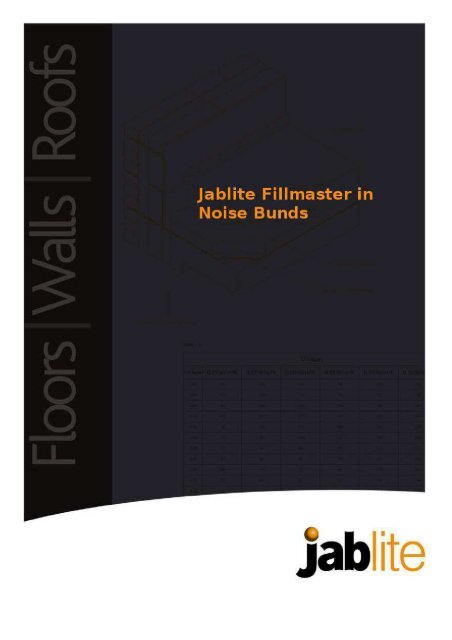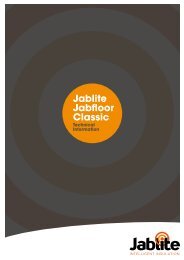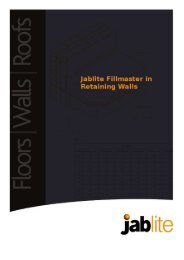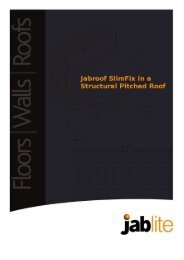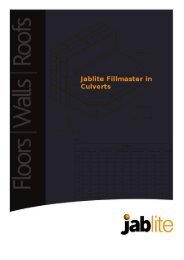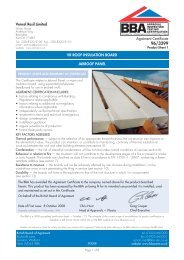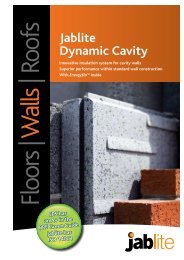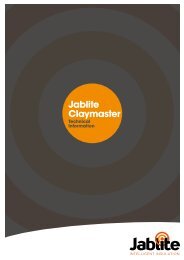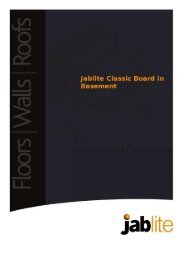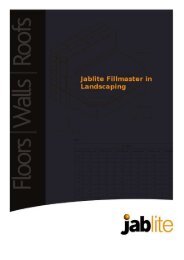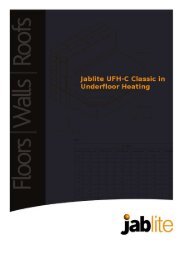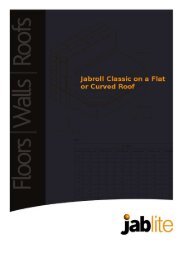Jablite Fillmaster in Noise Bunds
Jablite Fillmaster in Noise Bunds
Jablite Fillmaster in Noise Bunds
You also want an ePaper? Increase the reach of your titles
YUMPU automatically turns print PDFs into web optimized ePapers that Google loves.
8<br />
Design Consideration<br />
Traditional fill materials used to construct new embankments or<br />
placed aga<strong>in</strong>st civil eng<strong>in</strong>eer<strong>in</strong>g structures, can cause unacceptable<br />
vertical and/or horizontal stresses <strong>in</strong> the underly<strong>in</strong>g soil or aga<strong>in</strong>st<br />
the structure. The use of <strong>Fillmaster</strong> expanded polystyrene as a fill<br />
material offers a reliable, cost-effective lightweight solution to<br />
these problems, reduc<strong>in</strong>g the probability of further settlement or<br />
unacceptable lateral forces and often simplify<strong>in</strong>g the construction.<br />
Vencel Resil manufactures <strong>Fillmaster</strong> expanded polystyrene (EPS) blocks<br />
for use <strong>in</strong> civil eng<strong>in</strong>eer<strong>in</strong>g projects, especially road construction. The<br />
material is available <strong>in</strong> a range of sizes and strength grades. The cellular<br />
structure of the EPS material gives a high strength-to-weight ratio<br />
ensur<strong>in</strong>g that the blocks are able to withstand the mechanical loads<br />
encountered <strong>in</strong> road construction.<br />
Advantages<br />
■ Lightweight and easy to handle on site. Approximately 1% of the<br />
weight of traditional fill materials.<br />
■ Available <strong>in</strong> a range of grades allow<strong>in</strong>g the appropriate compressive<br />
strength to be chosen to suit each particular application.<br />
■ Closed-cell structure <strong>in</strong>hibits water absorption.<br />
■ Unaffected by normal range of climatic conditions.<br />
■ Immune to <strong>in</strong>sect, bacterial and fungal attack.<br />
Descri ption<br />
Grade<br />
<strong>Fillmaster</strong> is supplied <strong>in</strong> the grades shown <strong>in</strong> Table 1. Normally supplied<br />
as Euroclass F def<strong>in</strong>ed to BSEN 14933: 2007, it is also available as<br />
Euroclass E, flame-retardant additive material, if required.<br />
Dimensions<br />
<strong>Fillmaster</strong> standard block size:<br />
2440 x 1220 x 610mm; other sizes available to order to reduce the<br />
need for cutt<strong>in</strong>g to size on site. The stability of a lightweight<br />
embankment depends greatly on the uniformity of the blocks.<br />
Tolerances: ±3mm on thickness; ±4mm on width; and ±6mm on<br />
length. Maximum bow, 5mm over length of block.<br />
Application<br />
Expanded polystyrene has been successfully used as a fill material for<br />
highway embankments s<strong>in</strong>ce 1972. Its first such use <strong>in</strong> the UK was <strong>in</strong><br />
1985. The material is particularly beneficial <strong>in</strong> the follow<strong>in</strong>g situations<br />
where its use will obviate the need for either specialised foundations,<br />
or long surcharge periods designed to preload the ground and reduce<br />
settlement problems follow<strong>in</strong>g construction:<br />
■ Areas adjacent to exist<strong>in</strong>g embankments.<br />
■ Areas of unstable ground.<br />
■ Areas of weak or compressible soil.<br />
■ Sites where access is difficult or restricted.<br />
■ Ransition zones between bridges or underpasses and normal fill<br />
materials.<br />
Figure 1. HA Load<strong>in</strong>gs<br />
<strong>Fillmaster</strong><br />
blocks<br />
Pavement<br />
construction<br />
Buoyancy<br />
Reduced<br />
deadload of<br />
structure<br />
Compacted<br />
sand-levell<strong>in</strong>g<br />
course
9<br />
Table 1<br />
Physical Properties – <strong>Fillmaster</strong><br />
Design<br />
<strong>Fillmaster</strong> Grade FM50 FM70 FM100 FM150 FM200 FM250 FM300 FM350 FM400 FM500<br />
Compressive<br />
Stress at 1%<br />
stra<strong>in</strong> (kPa)<br />
Embankment forces<br />
There are three ma<strong>in</strong> design considerations when construct<strong>in</strong>g<br />
embankments us<strong>in</strong>g <strong>Fillmaster</strong>:<br />
10 20 45 70 90 100 120 140 160 190<br />
■ Downward pressure due to wheel load<strong>in</strong>gs and the self-weight of the<br />
embankment.<br />
■ Upward forces due to buoyancy <strong>in</strong> wet conditions.<br />
■ Lateral forces act<strong>in</strong>g aga<strong>in</strong>st abutments.<br />
Wheel load<strong>in</strong>gs<br />
In order to avoid unacceptable deflections and permanent deformation<br />
of the highway surface, the compressive stresses due to wheel load<strong>in</strong>gs,<br />
etc., should be carefully calculated and the appropriate grade of<br />
<strong>Fillmaster</strong> selected to ensure that these fall with<strong>in</strong> the design<br />
compressive strength of the material. It is recommended that this is<br />
carried out <strong>in</strong> accordance with the method of calculation for the<br />
thickness of sub-base/subgrade set out <strong>in</strong> BS 5400. This uses the<br />
convention of ‘HA’ and ‘HB’ units of load<strong>in</strong>g.<br />
HA load<strong>in</strong>g assumes a s<strong>in</strong>gle 100kN wheel load exert<strong>in</strong>g a pressure of<br />
1110kPa over a square of 300 x 300mm; the pressure is exerted<br />
downwards at a gradient of 2:1. This represents the effects of normally<br />
permitted vehicles.<br />
Design Consideration<br />
HB load<strong>in</strong>g represents the effects of abnormal loads on motorways and<br />
trunk roads. It is usual to design for 45 units of HB load<strong>in</strong>g; this<br />
represents the effect of 16 wheel loads each of 112.5kN exert<strong>in</strong>g a<br />
pressure of 1110kPa over a square of 318 x 318mm. The pressure is<br />
dispersed downwards at a gradient of 2:1.<br />
See Figures 2 and 3.<br />
Figure 2. HA Load<strong>in</strong>gs<br />
Depth <strong>in</strong> metres<br />
below surface<br />
100<br />
70<br />
45<br />
27<br />
21<br />
S<strong>in</strong>gle nom<strong>in</strong>al<br />
wheel HA load<strong>in</strong>g<br />
1 x 100kN<br />
Figure 3. HB Load<strong>in</strong>gs<br />
Depth <strong>in</strong> metres<br />
below surface<br />
4 x 112.5 4 x 112.5 4 x 112.5 4 x 112.5<br />
Approx pressure kN/m 2<br />
45 Units of<br />
HB Load<strong>in</strong>g<br />
For technical <strong>in</strong>formation 0870 444 8769 technical@vencel.co.uk
10<br />
Design Consideration<br />
Downward pressure<br />
When calculat<strong>in</strong>g the self-weight of <strong>Fillmaster</strong> blocks an allowance<br />
should be made for water absorption of less than 1% by volume.<br />
This gives a design weight of approximately 100kg/m 3 .<br />
Buoyancy pressures<br />
EPS is a proven flotation material and exerts a flotation force of<br />
900kgf/m 3 .<br />
This takes <strong>in</strong>to account a potential level of water absorption of 8% for<br />
blocks which are permanently submerged.<br />
Care must be taken dur<strong>in</strong>g the design process to ensure that the<br />
potential flotation forces can be accommodated with<strong>in</strong> the<br />
hydrological conditions of the site and take account of the self weight<br />
of the permanent structure.<br />
Alternatively, the material can be <strong>in</strong>stalled above the water table.<br />
The water table can be lowered by <strong>in</strong>stall<strong>in</strong>g suitable cut-off dra<strong>in</strong>s at<br />
the toe of the embankment or beneath the embankment itself.<br />
Lateral pressures<br />
When us<strong>in</strong>g <strong>Fillmaster</strong> for approach embankments to bridge<br />
abutments, the horizontal forces exerted on the abutment are almost<br />
eradicated. This allows economies to be made <strong>in</strong> the design of bridge<br />
foundations, which are no longer required to resist large rotational<br />
moments.<br />
Installation<br />
Construction of the embankment should proceed as follows:<br />
Levell<strong>in</strong>g course<br />
<strong>Fillmaster</strong> blocks are placed on a levell<strong>in</strong>g course consist<strong>in</strong>g of a layer of<br />
compacted sand to a maximum thickness of 100mm. This course<br />
should be laid to a level tolerance not exceed<strong>in</strong>g ±10mm over any 3m<br />
length. On sites which have very soft foundations, a geotextile layer<br />
may be placed on top of the soft soil before plac<strong>in</strong>g the sand fill, this<br />
prevents the sand from be<strong>in</strong>g ‘punched’ <strong>in</strong>to the soil.<br />
Lay<strong>in</strong>g the blocks<br />
The blocks <strong>in</strong> each layer should be laid with broken jo<strong>in</strong>ts; there should<br />
be no vertical or horizontal jo<strong>in</strong>ts runn<strong>in</strong>g through the construction.<br />
There is no need to compact the blocks dur<strong>in</strong>g construction.<br />
The coefficient of friction (µ) between adjacent blocks can be taken as<br />
0.5; this is normally sufficient to prevent any slippage or movement.<br />
When required, for example at the edges of the embankment,<br />
a positive fix<strong>in</strong>g can be obta<strong>in</strong>ed by driv<strong>in</strong>g 12mm diameter re<strong>in</strong>forc<strong>in</strong>g<br />
bars down through the layers.<br />
The f<strong>in</strong>al profile of the side slope will depend on the properties of the<br />
soil used. Where soil conditions restrict the available space for an<br />
embankment, a range of techniques is now available for construct<strong>in</strong>g<br />
steep sides or vertical faces.<br />
Cutt<strong>in</strong>g<br />
Blocks which require trimm<strong>in</strong>g can be easily cut us<strong>in</strong>g a hot-wire cutter,<br />
handsaw or cha<strong>in</strong> saw.<br />
Protection<br />
The <strong>Fillmaster</strong> should be protected from possible accidental contact<br />
with petroleum or solvents us<strong>in</strong>g a suitable polymer barrier, where<br />
necessary.<br />
Fill or capp<strong>in</strong>g layer<br />
The f<strong>in</strong>al fill should be placed over the <strong>Fillmaster</strong> blocks tak<strong>in</strong>g care not<br />
to puncture any membrane.<br />
No construction plant, other than compaction equipment, should be<br />
driven across, or placed on the <strong>Fillmaster</strong> until there is a m<strong>in</strong>imum<br />
cover of 200mm of acceptable fill material, or until the capp<strong>in</strong>g layer<br />
has been placed.<br />
Vibratory compaction plant should not be used with<strong>in</strong> 500mm<br />
vertically, or 2m laterally, of the <strong>Fillmaster</strong> blocks.<br />
Cover<br />
The sides of the <strong>Fillmaster</strong> blocks should be covered with general fill<br />
and compacted <strong>in</strong> layers. The sides should be graded and covered with<br />
top soil. The m<strong>in</strong>imum cover should be 300mm.<br />
References<br />
BS 5400 Steel, concrete and composite bridges. Part 2 Specification for loads. Department of Transport Standard BD 37/88. Loads for highway bridges.<br />
Geotechnical considerations and techniques for widen<strong>in</strong>g highway earthworks. Department of Transport.<br />
Plastic foam <strong>in</strong> road embankments. Proceed<strong>in</strong>gs of the conference of the Norwegian Plastics Federation. June 1985.<br />
TRL Contractor report 356. The use of polystyrene for embankment construction.
11<br />
Design Consideration<br />
For technical <strong>in</strong>formation 0870 444 8769 technical@vencel.co.uk
28<br />
<strong>Noise</strong> <strong>Bunds</strong><br />
Traditional materials used <strong>in</strong> the construction of noise bunds can<br />
often have a detrimental effect on surround<strong>in</strong>g structures and<br />
services. <strong>Fillmaster</strong> offers a cost-effective, lightweight solution<br />
which can be constructed to steeper gradients than conventional<br />
materials.<br />
Figure 19. <strong>Noise</strong> <strong>Bunds</strong><br />
Re<strong>in</strong>forced soil slope<br />
Sand-levell<strong>in</strong>g course<br />
<strong>Fillmaster</strong> blocks
29<br />
Figure 20. <strong>Noise</strong> <strong>Bunds</strong><br />
Re<strong>in</strong>forced soil slope<br />
<strong>Fillmaster</strong> blocks<br />
<strong>Noise</strong> <strong>Bunds</strong><br />
Sand-levell<strong>in</strong>g course<br />
M4, Cippenham, Berkshire<br />
To shelter residents of a new hous<strong>in</strong>g development from traffic noise<br />
on the adjacent M4 <strong>in</strong> Cippenham, near Slough, Berkshire, a noise bund<br />
was created.<br />
Part of this bund had to be built over an exist<strong>in</strong>g sewer system. Project<br />
architect, Clive Chapman, was concerned that the weight of traditional<br />
fill materials would have imposed unacceptable load<strong>in</strong>gs on the sewer.<br />
<strong>Fillmaster</strong> was specified which is only 1% of the weight of traditional<br />
fill materials and does not impose unacceptable stresses on nearby<br />
structures and services. This meant that the overall load<strong>in</strong>g on the<br />
sewer was m<strong>in</strong>imised. Some 1,100m 3 of <strong>Fillmaster</strong> was used <strong>in</strong> the<br />
construction of the bund.<br />
<strong>Fillmaster</strong>’s light weight and ease of handl<strong>in</strong>g also allowed subcontractor<br />
Dick Cookman (Plant Hire & Excavation) to reduce the<br />
overall project time and costs.<br />
Client: Eton College<br />
Design: Clive Chapman<br />
Contractor: Alfred McAlp<strong>in</strong>e<br />
Volume: 1,100m 3<br />
<strong>Noise</strong> bund, M4 Cippenham<br />
For technical <strong>in</strong>formation 0870 444 8769 technical@vencel.co.uk
44<br />
Technical Data<br />
Table 5. Physical Properties – <strong>Fillmaster</strong><br />
Physical Properties - <strong>Fillmaster</strong><br />
<strong>Fillmaster</strong> Grade FM50 FM70 FM100 FM150 FM200 FM250 FM300 FM350 FM400 FM500<br />
Compressive<br />
Stress at 1%<br />
stra<strong>in</strong> (kPa)<br />
10 20 45 70 90 100 120 140 160 190<br />
Biological properties<br />
EPS is not susceptible to attack by fungus or bacteria and is<br />
non-biodegradable. It offers no nourishment to vegetation or<br />
animal life.<br />
Chemical resistance<br />
EPS is resistant to most substances which occur naturally <strong>in</strong> soil, as well<br />
as to a wide range of common substances at ambient temperatures,<br />
<strong>in</strong>clud<strong>in</strong>g:<br />
■ alkalis<br />
■ dilute <strong>in</strong>organic acids<br />
■ gypsum plaster<br />
■ most alcohols<br />
■ portland cement<br />
■ silicone oil<br />
■ solvent-free bitumen<br />
If there is any possibility that the soil with which it is likely to come<br />
<strong>in</strong>to contact is contam<strong>in</strong>ated, for example when construct<strong>in</strong>g<br />
embankments on reclaimed <strong>in</strong>dustrial land, laboratory tests should be<br />
conducted to determ<strong>in</strong>e the exact nature of the contam<strong>in</strong>ants. Some<br />
materials, <strong>in</strong>clud<strong>in</strong>g vegetable oils, paraff<strong>in</strong>, animal fats and oils may<br />
attack the surface of the EPS caus<strong>in</strong>g shr<strong>in</strong>kage and deformation.<br />
However, they are not able to dissolve the EPS nor to penetrate the<br />
mass of the material and do not affect long-term stability.<br />
Durability<br />
When correctly specified and <strong>in</strong>stalled as a lightweight embankment<br />
fill, <strong>Fillmaster</strong> can be considered as a permanent material. <strong>Fillmaster</strong><br />
also has the added advantage of be<strong>in</strong>g floor-proof.<br />
Mechanical properties<br />
EPS behaves as a l<strong>in</strong>ear elastic material up to stra<strong>in</strong>s of 1% where the<br />
elastic limit is exceeded. A typical stress stra<strong>in</strong> curve is shown <strong>in</strong> Graph<br />
3. <strong>Fillmaster</strong> creep deformation can be disregarded <strong>in</strong> embankment<br />
applications.<br />
The coefficient of friction (µ) between blocks is around 0.5 along the<br />
moulded faces; the figure is higher on cut faces s<strong>in</strong>ce the surface<br />
roughness is <strong>in</strong>creased.<br />
Poissons ratio 0.02.<br />
Moisture properties<br />
EPS is not soluble <strong>in</strong> water and will not usually exceed a moisture<br />
absorption level of 8-10% after long-term immersion.<br />
The closed-cell structure prevents the migration of liquids through the<br />
mass of the material.<br />
Graph 2. Typical stress stra<strong>in</strong> curve<br />
EPS should not allowed to come <strong>in</strong>to contact with hydrocarbons,<br />
chlor<strong>in</strong>ated hydrocarbons, organic solvents such as ketones, ethers and<br />
esters; diesel and petroleum fuels; and concentrated acids.<br />
If there is any possibility of contact with these substances, either<br />
dur<strong>in</strong>g or after construction, the material should be protected by us<strong>in</strong>g<br />
an impermeable polymer membrane as a physical barrier. Further<br />
<strong>in</strong>formation is available from Vencel Resil’s technical services<br />
department.<br />
Stress<br />
1 Stra<strong>in</strong> (%)<br />
10
45<br />
Fire<br />
<strong>Fillmaster</strong> is normally supplied as Euroclass F material as def<strong>in</strong>ed <strong>in</strong><br />
BS EN 14933: 2007; Euroclass E, flame-retardant additive material is<br />
also available. EPS will ignite on contact with an open flame and will<br />
burn readily <strong>in</strong> the presence of air. Care should be taken dur<strong>in</strong>g<br />
construction to ensure that the material is not exposed to possible<br />
sources of ignition. The use of the flame-retardant additive material will<br />
<strong>in</strong>hibit the early stages of the development of a fire.<br />
Small quantities of residual blow<strong>in</strong>g agent may be present and advice<br />
should be sought from Vencel Resil’s technical services department<br />
when <strong>in</strong>corporat<strong>in</strong>g the product <strong>in</strong> areas of low natural ventilation.<br />
Fire is not normally a hazard once the material has been placed and<br />
covered.<br />
Combustion<br />
EPS is ‘combustible’ as def<strong>in</strong>ed <strong>in</strong> BS 476:Part 4. When burn<strong>in</strong>g,<br />
EPS behaves like other hydrocarbons such as wood and paper.<br />
For Euroclass F material, the products of uncontrolled combustion are<br />
carbon monoxide, carbon dioxide, styrene, and water vapour; the<br />
decompos<strong>in</strong>g styrene will emit a certa<strong>in</strong> amount of dense black soot.<br />
Euroclass E material also emits hydrogen bromide when burn<strong>in</strong>g.<br />
Ignition temperature<br />
Flash ignition temperature is between 350 and 490ºC depend<strong>in</strong>g on<br />
the application and the exact circumstances of use. Under certa<strong>in</strong><br />
circumstances the material can be readily ignited by a naked flame,<br />
but provid<strong>in</strong>g it is correctly <strong>in</strong>stalled this does not present any<br />
disadvantage <strong>in</strong> use.<br />
Calorific value: 40MJ/kg.<br />
Specific heat capacity: 1.13kJ/kgºC.<br />
Environmental issues<br />
EPS does not conta<strong>in</strong> or produce HCFCs, nor are these compounds used<br />
<strong>in</strong> its manufacture. In use, it is non-toxic, non-irritant and odourless.<br />
Due to the high volume and low weight of a lorry load of <strong>Fillmaster</strong><br />
there are environmental advantages over traditional materials <strong>in</strong><br />
reduc<strong>in</strong>g the number of lorry runs required to supply a contract.<br />
This can be particularly advantageous <strong>in</strong> built-up environments.<br />
(90m 3 of EPS compared to typically 10m 3 of traditional fill per<br />
lorry load).<br />
The low density of <strong>Fillmaster</strong>, which is typically 95-98% air, directly<br />
reduces the volumes of quarried materials required.<br />
Health & Safety<br />
EPS scores particularly highly when it comes to health and safety. It has<br />
many positive attributes, not the least of which is its proven safety<br />
record from production through useful life to recycl<strong>in</strong>g. EPS is non-toxic<br />
and biologically <strong>in</strong>ert. The material is not irritat<strong>in</strong>g to the sk<strong>in</strong> or eyes;<br />
no medical treatment or action is required as a result of accidental<br />
<strong>in</strong>gestion.<br />
No special precautions are required dur<strong>in</strong>g handl<strong>in</strong>g or cutt<strong>in</strong>g where<br />
carried out <strong>in</strong> a well ventilated area. Dust produced by cutt<strong>in</strong>g is very<br />
light and may cl<strong>in</strong>g to the sk<strong>in</strong> or cloth<strong>in</strong>g through static electricity;<br />
it may be simply brushed away.<br />
The volume of air <strong>in</strong> EPS boards is 98%, consequently the components<br />
<strong>in</strong> a given volume are correspond<strong>in</strong>gly low, typically 15 to 50 kg/m 3 .<br />
In polystyrene, styrene monomer, shown to be safe <strong>in</strong> use, constitutes<br />
up to 0.1% by weight of the product. This m<strong>in</strong>ute trace of styrene<br />
monomer constitutes no threat to health.<br />
The expand<strong>in</strong>g agent pentane, is a saturated hydrocarbon (not to be<br />
confused with (HCFCs) and is non-toxic and constitutes no threat<br />
to the ozone layer. Euroclass E, flame-retardant additive material,<br />
conta<strong>in</strong>s around 0.5% of the flame retardant hexabromocyclododecane<br />
(HBCDD) which is entrapped <strong>in</strong> the polymer matrix of the EPS.<br />
The HBCDD additive should not be confused with aromatic flame<br />
retardants (such as PBBs and PBBOs).<br />
Technical Data<br />
For technical <strong>in</strong>formation 0870 444 8769 technical@vencel.co.uk
For more <strong>in</strong>formation about<br />
<strong>Jablite</strong> please contact us on:<br />
Tel: 0870 600 3666<br />
Email: sales@jablite.co.uk<br />
Visit: www.jablite.co.uk<br />
<strong>Jablite</strong> Limited<br />
Head Office: Inf<strong>in</strong>ity House, Anderson Way, Belvedere, Kent DA17 6BG


